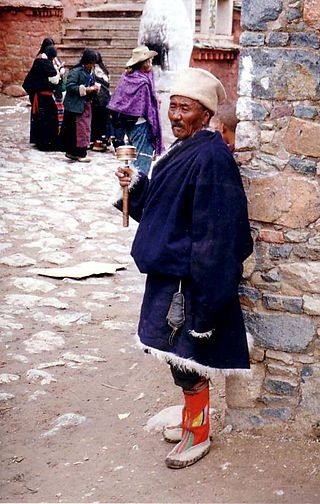Related Research Articles

The Yamuna is the second-largest tributary river of the Ganges by discharge and the longest tributary in India. Originating from the Yamunotri Glacier at a height of about 4,500 m (14,800 ft) on the southwestern slopes of Bandarpunch peaks of the Lower Himalaya in Uttarakhand, it travels 1,376 kilometres (855 mi) and has a drainage system of 366,223 square kilometres (141,399 sq mi), 40.2% of the entire Ganges Basin. It merges with the Ganges at Triveni Sangam, Prayagraj, which is a site of the Kumbh Mela, a Hindu festival held every 12 years.

Nahar Singh Mahal is located at Ballabhgarh in Faridabad district of Haryana. This fort was built by the forefathers of Raja Nahar Singh around 1739 AD, and after whom Ballabgarh was named, the construction however continued in parts till about 1850. The fort is also known as Raja Nahar Singh Palace.

The National Capital Region (NCR) is a planning region centered upon the National Capital Territory (NCT) of Delhi in India. It encompasses Delhi and several districts surrounding it from the states of Haryana, Uttar Pradesh, and Rajasthan. The NCR and the associated National Capital Region Planning Board (NCRPB) were created in 1985 to plan the development of the region and to evolve harmonized policies for the control of land-uses and development of infrastructure in the region. Prominent cities of NCR include Delhi, Faridabad, Ghaziabad, Gurgaon and Noida.

East Punjab was a province of India from 1947 until 1950. It consisted parts of the Punjab province that remained in India following the partition of the province between the new dominions of Pakistan and the Indian Union by the Radcliffe Commission in 1947. The mostly Muslim western parts of the old Punjab became Pakistan's West Punjab, later renamed as Punjab Province, while the mostly Hindu and Sikh eastern parts remained with India.
Tyagi, originally called Taga, is a cultivator caste who claim Brahmin status. The landholding community is confined to Western Uttar Pradesh, Haryana, Delhi and Rajasthan. They are often considered the highest of the agricultural castes. During the British Raj, they changed their name from Taga to Tyagi, and began claiming Brahmin status. As of a 1990 report by the Backward Classes Commission, Government of Haryana, they were mostly engaged in farming. The Government of Haryana granted reservation to Tyagis along with five other castes in 2016. However, the Punjab and Haryana High Court shortly put a stay on the government's order.

The most important places in Buddhism are located in the Indo-Gangetic Plain of southern Nepal and northern India. This is the area where Gautama Buddha was born, lived, and taught, and the main sites connected to his life are now important places of pilgrimage for both Buddhists and Hindus. Many countries that are or were predominantly Buddhist have shrines and places which can be visited as a pilgrimage.

Telephone numbers in India are administered under the National Numbering Plan of 2003 by the Department of Telecommunications of the Government of India. The numbering plan was last updated in 2015. The country code "91" was assigned to India by the International Telecommunication Union in the 1960s.
North Indian cuisine is collectively the cuisine of Northern India, which includes the cuisines of Jammu and Kashmir, Punjab, Haryana, Himachal Pradesh, Rajasthan, Uttarakhand, Delhi, Uttar Pradesh Bihar, Jharkhand, Chhattisgarh and Madhya Pradesh.

The following outline is provided as an overview of, and topical guide to, India:

Ranghar are a community of Muslim Rajputs in the Indian states of Haryana, Punjab, Himachal Pradesh, Delhi and Uttar Pradesh; and in Sindh (Muhajirs) and Punjab in Pakistan.

Haryana Pradesh Congress Committee is the unit of the Indian National Congress, working in the state of Haryana. It is responsible for organizing and coordinating the party's activities and campaigns within the state, as well as selecting candidates for local, state, and national elections. Its head office is situated at Chandigarh. Senior leader and four times MLA Mr Udai Bhan is the present chief of the Haryana Pradesh Congress Committee.

The Himalayan Expressway is a 27.5 km stretch of highway in India that runs through the Shivaliks at the trijunction of Haryana, Punjab, and Himachal Pradesh. It is part of the Chandigarh–Shimla Expressway which connects Zirakpur in Punjab to Parwanoo in Himachal Pradesh. It forms part of National Highway 5. The stretch runs through 2 km in Zirakpur, Punjab, 21 km in Panchkula, Haryana, and 4.5 km in Parwanoo, Himachal Pradesh. It was constructed by Jaypee Group.

National Highway 7 is a highway connecting Fazilka (Punjab) to Mana (Uttarakhand) in India. It passes through the Indian states of Punjab, Haryana, Himachal Pradesh, and Uttarakhand.

The 2004–05 Ranji Trophy was the 71st season of the Ranji Trophy. Railways defeated Punjab on first innings lead in the final.
National Highway 344 is a national highway in India running from Ambala in Haryana to Roorkee in Uttarakhand. It is a secondary route of National Highway 44. NH-344 runs in the states of Haryana, Punjab, Uttar Pradesh and Uttarakhand in India.

National Highway 105, commonly referred to as NH 105, is a national highway in India running from Pinjore in Haryana to Swarghat in Himachal Pradesh. The highway passes through the states of Himachal Pradesh and Haryana.
National Highway 709A, commonly called NH 709A is a national highway in India. It is a spur road of National Highway 9. NH-709A traverses the states of Haryana and Uttar Pradesh in India. Karnal to Meerut section has been upgraded from 4 lanes to 6 lanes by Public Works Department, Haryana.
National Highway 334D, commonly referred to as NH 334D is a national highway in India. It is a secondary route of National Highway 34. NH-334D runs in the states of Uttar Pradesh and Haryana in India.
References
- ↑ Socio-economic Profile of Rural India (series II).: North and central India (Punjab, Haryana, Himachal Pradesh and Madhya Pradesh). Vol. 5. Concept Publishing Company. 2011. p. 140. ISBN 978-81-8069-736-4.